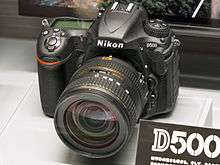Nikon D500
 | |
| Overview | |
|---|---|
| Type | Digital single-lens reflex |
| Lens | |
| Lens | Interchangeable, Nikon F-mount |
| Sensor/Medium | |
| Sensor | Nikon DX format, 23.5 mm x 15.7 mm CMOS; 4.2 µM pixel size |
| Image sensor maker | Sony[1] |
| Maximum resolution | 5,568 × 3,712 (20.9 M pixels sensor) |
| ASA/ISO range | 100–51,200 in 1, 1/2 or 1/3 EV steps (down to 50 and up to 1,640,000 as expansion) |
| Recording medium | SD/SDHC/SDXC (UHS-II) and XQD |
| Focusing | |
| Focus modes | Instant single-servo AF (S), continuous-servo AF (C), manual (M) |
| Focus areas |
153 points, 99 cross-type sensors User-selectable: 55 points, 35 cross-type |
| Exposure/Metering | |
| Exposure modes | Programmed Auto [P] with flexible program; Shutter-Priority Auto [S]; Aperture Priority Auto [A]; Manual [M] |
| Exposure metering | Three-mode through-the-lens (TTL) exposure metering |
| Flash | |
| Flash | External |
| Shutter | |
| Shutter | Electronically controlled vertical-travel focal plane shutter |
| Shutter speed range | 30 s – 1/8000 s, bulb |
| Continuous shooting | 10 frame/s, up to 200 frames (RAW) |
| Viewfinder | |
| Viewfinder | Optical, 100% frame coverage |
| General | |
| Rear LCD monitor | 3.2-inch tilting TFT LCD with 2,359,000 dots with touchscreen |
| Battery | EN-EL15 |
| Optional battery packs | MB-D17 battery pack |
| Weight |
860 g (1.90 lb) with battery and memory card 760 grams (1.68 lb) body only |
The Nikon D500 is a 20.9-megapixel professional digital single-lens reflex camera using an APS-C sensor. It was announced by Nikon Corporation on 6 January 2016 along with the Nikon D5 FX format camera.[2][3] It replaced the D300S as Nikon's DX format flagship DSLR. On 23 February 2017, at CP+ show, a special edition was released for Nikon's 100th anniversary.[4] D500 jointly won a Camera Grand Prix Japan 2017 Editors Award.[5]
Features
- 4K UHD video in 30p, 25p, and 24p
- Magnesium alloy and carbon fiber weather-sealed body
- Active D-Lighting (three levels)
- Retouch menu includes filter type, hue, crop, D-lighting, Mono (Black and White, Cyanotype or Sepia)
- Multi-CAM 20K autofocus module with 153 sensors in normal mode with 99 cross-type sensors. Of these points, 15 will work with any lens/teleconverter combination with a maximum aperture of f/8 or larger.
- Of the 153 points, 55 are user-selectable; 35 of those points are cross-type, and 9 will work down to f/8.[6]
- Focus points' low-light performance: -4EV (central focus point) and -3EV (other 152 focus points)
- Auto AF fine-tune achieves focus tuning in live view through automatic setting of adjustment value with a few button operations.
- Live View Mode
- Built-in sensor cleaning (using ultrasound) helps to remove the dust from sensor
- 10-pin remote and flash sync terminals on camera
- File formats include JPEG, TIFF, NEF (Nikon's raw image format compressed and uncompressed), and JPEG+NEF (JPEG size/quality selectable)
- Dual memory card slots (one SD and one XQD). The SD slot is the first in any Nikon camera to support the UHS-II bus.[7]
- The D500 can be set to automatically delay its shutter release to compensate for flickering electric lighting. It is the first Nikon camera to include this feature, which was initially absent from the professional D5 announced on the same date.[6] This feature was added to the D5 via a June 2016 firmware update.[8]
Service advisory
The Nikon D500 uses the popular Nikon EN-EL15 battery and is shipped with the current Li-ion20 version. If used with the previous generation Li-ion01 version, the D500 may report a low amount of charge remaining, and take fewer shots than expected from a fully charged battery. On May 27, 2016, Nikon announced they will replace older EN-EL15 Li-ion01 batteries for D500 owners.[9]
References
- ↑ Nikon D5 and D500 Image Sensors are Made by Sony Daily Camera News
- ↑ "Nikon - News - Digital SLR Camera D500". Nikon. Retrieved 2016-01-06.
- ↑ Hogan, Thom. "D500". DSLR Bodies. Retrieved 6 January 2016.
- ↑ "These are Nikon's Ultra-Limited Edition 100th Anniversary DSLRs and Lenses". PetaPixel. 2017-02-27. Retrieved 2017-02-28.
- ↑ Camera Grand Prix 2017
- 1 2 Rockwell, Ken (January 2016). "Nikon D500". KenRockwell.com. Retrieved January 7, 2016.
- ↑ "Nikon D500 XQD and SD Card Comparison". Camera Memory Speed. May 4, 2016. Retrieved August 29, 2017.
- ↑ Britton, Barney (June 23, 2016). "Nikon releases new firmware for D5: Improves video and adds flicker reduction". Digital Photography Review. Retrieved June 25, 2016.
- ↑ To owners of the Nikon D500 digital SLR camera | Nikon Knowledgebase
External links
| Wikimedia Commons has media related to |
- Nikon D500, Nikon USA
- Nikon D500 User Manuals, Guides and Software Nikon Download-center
- Technical Solutions | D500 TIPS Nikon
See also: Nikon 1 / F-mount – Teleconverter – CX / DX format – Speedlight – Expeed | |||||||||||||||||||||||||||||||||||||||||||||||||||||||||||||||||||||||||||||||||||||||||||||||||||||||||||||||||||||||||||||||||||||||||||||||||||||||||||||||||||||||||||||||||||||||||||||||||||||||||||||||||||||||||||||||||||||||||||||||||||||||||||||||||||||||||||||||||||||||||||||||||||||||||||||||||||||||||||||||||||||||||||||||||||||||||||||||||||||||||||||||||||||||||||||||||||||||||||||||||||||||||||||||||||||||||||||||||||||||||||||||||||||||||||||||||||||||||||||||||||||||||||||||||||||||||||||||||||||||||||||||||||||||||||||||||||||||||||||||||||||||||||||||||||||||||||||||||||||||||||||||||||||||||||||||||||||||||||||||||||||||||||||||||||||||||||||||||||||||||||||||||||||||||||||||||||||||||||||||||||||||||||||||||||||||||||||||||||||||||||||||||||||||||||||||||||||||||||||||||||||||||||||||||||||||||||||||||||||||||||||||||||||||||||||||||||||||||||||||||||||||||||||||||||||||||||||||||||||||||||||||||||||||||||||||||||||||||||||||||||||||||||||||||||||||||||||||||||||||